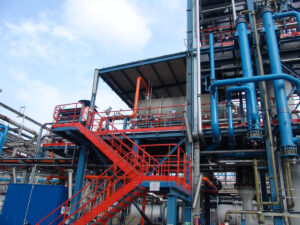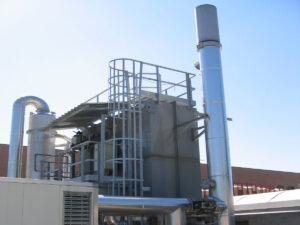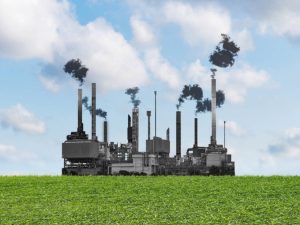- The production of environmentally friendly and recyclable flexible food packaging
- Technological evaluation for proper emission abatement in flexible food packaging production with water-based coatings
- Application of wet scrubbers for purifying emissions containing amines, ketones, alcohols, ammonia, and nitriles
- BrofindⓇ air emission abatement systems: beyond compliance, toward total sustainability
- Go to the gallery with all our systems
Wet scrubber system for VOCs control in flexible food packaging manufacturing line
It is becoming increasingly common to apply water-based coatings to flexible food packaging manufacturing processes. However, the paints currently used contain a minimal amount of Volatile Organic Compounds (VOCs) that can be emitted into the atmosphere within the most stringent regulatory limits.
The production of environmentally friendly and recyclable flexible food packaging
In the actual case presented here, an abatement system capable of taking into account the peculiarities of the pollutant compounds in the paints used was successfully installed.
The project was implemented to ensure regulatory compliance, reduce environmental impact and improve the overall sustainability of the client company, a global leader in the development and production of responsible, high-quality packaging solutions for food, beverages, pharmaceuticals and other products.
The selected technology, compared with existing technological alternatives, was found to be the most sustainable, taking with of several aspects, namely:
- environmental impact
- operating costs
- the initial investment
In addition to this, the project helped promote the image of environmental responsibility and improve the ESG rating of the client company.
The client to whom the project described here relates is a multinational company dedicated to the production of flexible packaging used in a variety of applications in a wide range of industries, including food, beverage, healthcare, and household and personal products. In 2018, the company made an ambitious commitment to make all of its packaging recyclable or reusable by 2025, demonstrating a strong commitment to environmental sustainability.
In line with this company policy, the company has installed a number of water-based coating lines for the production of high-performance, recyclable multilayer technical films. The use of water-based coatings, replacing alternatives that use organic solvents, is undoubtedly a big step toward sustainability and respect for the environment.
Water-based paints currently on the market, however, contain a number of polluting compounds that, even if present in minute amounts, can have a negative impact on the environment and health.
The goal for BrofindⓇ is not only to ensure regulatory compliance, but also to provide sustainable and safe packaging production solutions to our customers, thus contributing to a greener and more responsible future for all.
Technological evaluation for proper emission abatement in flexible food packaging production with water-based coatings
The treatment of air emissions from the water-based coating processes characteristic of the client’s production lines was carefully considered, comparing the different technologies available and evaluating which, among them, could be most effective and sustainable.
At this technical assessment stage, thermal oxidation technologies were discarded, as they are characterized by high energy consumption and high impact on CO2 production.
VOC recovery technologies were not applicable, due to the complexity of the mixture of VOCs present and the small amount used, which did not make the investment in a solvent recovery plant economically justifiable.
Adsorption technologies, for example on activated carbon, were not considered optimal because of the high consumption of activated carbon that would be required to treat emissions with characteristics too far from optimal to allow efficient adsorption.
Coatings used in water-based coating processes of flexible packaging contain products that, of necessity, must be compatible with the presence of water, which remains the main solvent used for applying the coating to the flexible film; these products mainly fall into the following chemical species:
- Amines: can cause skin, respiratory and eye irritation and have a major impact in the formation of tropospheric ozone, a harmful air pollutant as well as contribute to contamination of surface and groundwater, damaging aquatic ecosystems
- Ketones: can cause skin and respiratory irritation, polluting air and water; if treated with activated charcoal, can generate low temperature flammability, often causing fires
- Alcohols: can cause serious health damage if ingested or inhaled in large quantities. They can contribute to the greenhouse effect.
- Ammonia: This compound can irritate the eyes, nose and throat, as well as cause lung damage if inhaled in high concentrations. Ammonia can pollute surface and groundwater, causing damage to aquatic ecosystems.
- Nitriles: Used as solvents and additives, they are toxic to aquatic organisms and can pollute surface waters if not treated properly.
Application of wet scrubbers for purifying emissions containing amines, ketones, alcohols, ammonia, and nitriles
The solution identified and capable of enabling the best performance, not only in terms of removal efficiency, but also in terms of ease of use, operating cost containment and able to minimally interfere with the customer’s production process, involved wet abatement of pollutants due to their high solubility in water.
The designed wet scrubber system consists of a first vertical section, in which polluted air passes through an extensive water contact surface, achieved by installing specially designed fill bodies for this purpose.
In this surface, pollutants tend to solubilize in the water, transferring from the air, which is thus purified. The constant flow of water is ensured by a special supply circuit that, through pumps, allows the water used in the process to be recirculated, thus limiting water consumption to a minimum.
A second final section, in which non-recirculated water is fed, allows further abatement of those minute residual amounts of pollutant that were not abated in the first section, thus enabling the highest abatement yields.
Since some factors greatly influence the water solubility of chemical compounds, there is provision for controlling the temperature of water used in the process through an appropriate cooling section.
The plant is operated fully automatically, and in order to achieve the highest purification efficiency at all times, all the most significant process parameters are continuously monitored through sophisticated instrumentation, including:
- water consumption
- The amount of water discharged,
- The salt concentration of the water used
- the stack emissions of VOCs.
- electrical consumption
BrofindⓇ air emission abatement systems: beyond compliance, toward total sustainability
The installed system minimized the environmental impact of the flexible film coating processes with water-based coatings used by the customer, allowing a further step toward sustainability of an already environmentally advanced production process.
The plant has been able to comply with emission limits well below contract limits, and emission monitoring allows for continuous monitoring of regulatory compliance and abatement efficiency. In fact, the supervisory system that manages the plant allows for the detection of any anomalies and is able to alert operators by integrating with the company’s production system, enabling immediate intervention even for our remote service.
It is critical for our clients to not only comply with environmental regulatory limits, but to use state-of-the-art solutions that can enable them to achieve excellence in their business.
The plant was built in accordance not only with the requirements of the relevant technical regulations, but also in compliance with the construction standards considered by the client, a multinational market leader in its field, in which safety aspects are considered fundamental.


